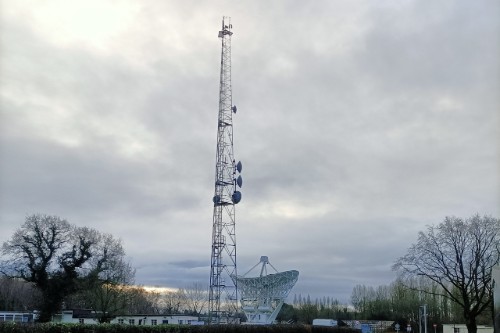
Image shows the new atmospheric monitoring station at Jodrell Bank Observatory in Cheshire.
The UK's ability to measure greenhouse gases has taken a step forward thanks to a new atmospheric monitoring station.
The station, led by the University of Bristol and University of Manchester, will provide data to improve estimates of emissions, including atmospheric hydrogen generated through the nation's expanding hydrogen economy.
Simon O'Doherty, Professor of Atmospheric Chemistry at the University of Bristol, said: "We can only understand the levels of greenhouse gases in the atmosphere by making continuous high-quality, physical measurements of the atmosphere.
"The current UK network of monitoring stations set up in 2012 has been a huge success in furthering our understanding, however, the addition of the Jodrell Bank station to the network will enhance our ability to determine emissions in the north-west region of the UK."
Based at the Jodrell Bank Observatory in Cheshire, the station forms part of the UK's Greenhouse Gas Emissions and Modelling Advancement (GEMMA) programme. The facility includes equipment for measuring the key greenhouse gases: carbon dioxide (CO2), methane (CH4), and nitrous oxide (N2O), in addition to carbon monoxide (CO), which acts as an indirect greenhouse gas and provides a useful tracer for combustion emissions. A high-precision analyser for monitoring atmospheric hydrogen (H2) will also soon be in action at the site.
Measurements collected there will be added to a long-term dataset gathered by the UK's Deriving Emissions linked to Climate Change (DECC) network. These measurements are combined with a computer model representing the transport of gases from the emission sources to the measurement locations. This allows scientists to estimate the size and location of emissions for each measured gas. The total UK emissions estimated for CH4 and N2O using this method are included in the UK's National Inventory Report, which is submitted annually to the United Nations Framework Convention on Climate Change.
As the first site of its kind in north-west England, the new Jodrell Bank station will provide more granular detail on emissions from Wales and north-west England. Besides improving the accuracy of UK emission estimates, it will also facilitate new studies focused on regional greenhouse gas emissions. In addition, Jodrell Bank is well-placed to monitor changes in atmospheric hydrogen resulting from planned industrial developments near Ellesmere Port.
The GEMMA Programme is a consortium led by the National Physical Laboratory (NPL), which includes the Met Office, National Centre for Earth Observation, National Centre for Atmospheric Science, University of Bristol, University of Manchester, and others working together to create a single integrated network to monitor all sources and sinks of greenhouse gases in the UK, funded by NERC and the Building a Green Future Programme.
Grant Allen, Professor of Atmospheric Physics at The University of Manchester, said: "This new measurement station will add important new data on greenhouse gas emissions in north-west England and Wales, allowing us to objectively track our progress towards net zero."
Alistair Manning, Met Office greenhouse gas monitoring Scientific Manager, added: "Jodrell Bank is ideally located to monitor emissions from north Wales and the north-west of England. It complements the existing network perfectly and will enable a better spatial understanding of the emissions of greenhouse gases from these regions. The resulting information will enable the UK to better understand its current emissions and monitor its progress to net zero."






